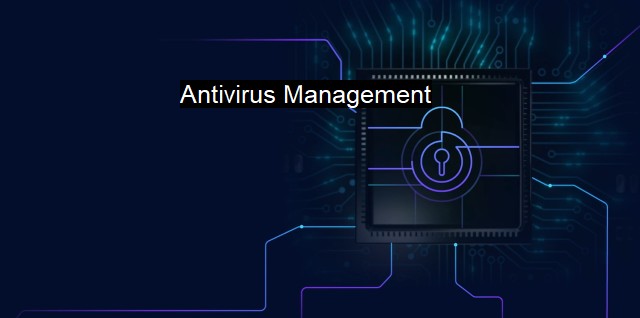What is Antivirus Management?
Securing Your Organization with Effective Antivirus Management Strategies: The Importance of Keeping Up-to-Date and Comprehensive Protection Across Networks.
"Antivirus management" refers to the process of deploying, monitoring, updating, and managing antivirus software across a computer network. It forms a vital component of cybersecurity strategies, designed to prevent, detect, and eradicate viruses and other forms of malicious software (also known as "malware").At the core of antivirus management is the deployment of antivirus software. This pertains to the installation of antivirus applications on all devices within the network, including workstations, mobile devices, and servers. Selection of a reliable antivirus application is of paramount importance during the deployment phase. Factors such as the proficiency of malware detection, system demand, counting of false alarms, and ease of managing network security within an organization play a significant role in the choice of antivirus application.
Monitoring and updating of the antivirus software in every single device in a network are vital parts of antivirus management. Companies must ensure that the antivirus software is constantly refreshed with the newest definitions, which are often released by vendors to aid the software in effectively recognizing the latest threats. Antivirus software that isn’t updated regularly may not provide adequate protection against new or evolving malware. Hence, keeping the antivirus software updated bridges this potential gap in the security framework.
Another salient facet of antivirus management is the management of quarantine and virus vault areas. Protecting the PC against viruses is a proactive strategy, but there may be instances when a threat sneaks past the real-time scanning function of the antivirus. In such cases, the software activates its reactive strategy and offers quarantine or virus vault options to encapsulate the threat and prevent it from affecting other files and systems.
Antivirus management often implies inspecting the threat landscape to devise suitable strategies. It enables the network administrator to evaluate network traffic and scan for vulnerabilities in the secure systems. This includes regularly scanning every machine ensuring that they are absent of threats or that detected threats are swiftly responding to establish system safety.
Antivirus management also undertakes the tracking and analysis of threats. Antivirus logs provide a wealth of information about the various kinds of threats faced by the system and how the antivirus software responded to them. Efficient antivirus management systems narrate a threat life cycle that helps build strategies for dealing with familiar threats in more efficient ways and bolstering defense mechanisms.
In the broader perspective of cybersecurity, antivirus management is part of a layered security approach. While it excels in preventing, detecting, and eradicating most malware, it cannot counter all of today's sophisticated threats alone. Consequently, antivirus management should work hand in hand with other tools and measures like firewalls, anti-spam, intrusion detection systems, and user awareness training.
Another significant challenge that antivirus management faces is to run extensive suites without excessively encumbering system resources, as some antivirus solutions can inadvertently slow down computers, or cause related performance issues. Accordingly, implementation and management strategies should balance security efficacy with resources management.
In a shortage-age where malicious activities are increasing exponentially, proper antivirus management is irrefutable against the constant threat of disruption. The ease of managing the deployment, updates, monitoring and reporting tools comes with a centralized antivirus management approach. This approach provides organizations with comprehensive visibility and control over their network security infrastructure. It's safe to say that antivirus management is equivalent to a safety helmet for the users who sail on the dangerous waters of the internet, providing much-needed protection.

Antivirus Management FAQs
What is antivirus management?
Antivirus management refers to the process of installing, configuring, and updating antivirus software on a computer system to protect it against potential cyber threats such as malware, viruses, and other malicious software.Why is antivirus management important in cybersecurity?
Antivirus management is crucial in cybersecurity because malware and viruses can cause significant harm to a computer system or network. Antivirus software can detect, block, and remove these malicious programs before they cause damage to the system. Proper antivirus management ensures that the software is up-to-date and running effectively to provide maximum protection against cyber threats.How often should antivirus software be updated?
Antivirus software should be updated regularly to ensure that it remains effective against the latest cyber threats. Most antivirus software can be configured to update automatically, which is the recommended setting to ensure that the updates are installed in a timely manner. In addition to automatic updates, it is always a good practice to run a manual update periodically to ensure that the software is up-to-date.What are the best practices for antivirus management?
Some best practices for antivirus management include selecting a reputable antivirus software vendor, configuring the software according to recommended settings, enabling automatic updates, performing regular scans of the computer system, and ensuring that the antivirus software is up-to-date. It is also important to educate employees on the importance of proper antivirus management and cybersecurity practices to reduce the risk of cyber attacks.| | A | | | B | | | C | | | D | | | E | | | F | | | G | | | H | | | I | | | J | | | K | | | L | | | M | |
| | N | | | O | | | P | | | Q | | | R | | | S | | | T | | | U | | | V | | | W | | | X | | | Y | | | Z | |
| | 1 | | | 2 | | | 3 | | | 4 | | | 7 | | | 8 | | |||||||